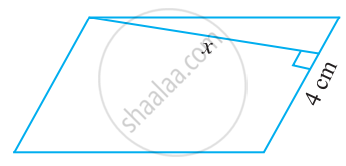Advertisements
Advertisements
प्रश्न
Find the missing values.
| Base | Height | Area |
| 17 mm | 221 sq.mm |
उत्तर
Given: Height h = 17 mm
Area of the parallelogram = 221 sq.mm
b × h = 221
b × 17 = 221
b = `221/17`
b = 13 m
Tabulating the results, we get
| Base | Height | Area |
| 13 m | 17 mm | 221 sq.mm |
APPEARS IN
संबंधित प्रश्न
PQRS is a parallelogram (see the given figure). QM is the height from Q to SR and QN is the height from Q to PS. If SR = 12 cm and QM = 7.6 cm. Find:
- the area of the parallelogram PQRS
- QN, if PS = 8 cm

A parallelogram has sides of 15 cm and 12 cm; if the distance between the 15 cm sides is 6 cm; find the distance between 12 cm sides.
A parallelogram has sides of 20 cm and 30 cm. If the distance between its shorter sides is 15 cm; find the distance between the longer sides.
The adjacent sides of a parallelogram are 21 cm and 28 cm. If it's one diagonal is 35 cm; find the area of the parallelogram.
Find the height ‘x’ if the area of the parallelogram is 24 cm2 and the base is 4 cm.

The area of parallelogram whose base 10 m and height 7 m is
The base of the parallelogram is 16 cm and the height is 7 cm less than its base. Find the area of the parallelogram
Find the missing value:
| Base | Height | Area of parallelogram |
| 15.6 cm | ______ | 16.38 cm2 |
In the given figure, find the area of parallelogram ABCD, if the area of shaded triangle is 9 cm2.

ABCD is a parallelogram in which AE is perpendicular to CD as shown in the given figure. Also, AC = 5 cm, DE = 4 cm and area of ΔAED = 6 cm2. Find the perimeter and area of parallelogram ABCD.
